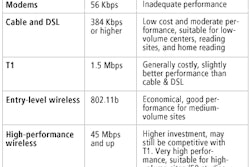A promotion, a bigger paycheck, or a new location may seem like the most obvious factors behind an employee's decision to change jobs. But most workers leave for more esoteric reasons, according to Suzanne Metzger, president of Corporate Masters, a management-consulting firm in Avon, IN.
"The number one reason (why people switch jobs every two years) is that their own personal value system does not match the value system of the company that they are working for," Metzger said in a presentation at the 2002 American Healthcare Radiology Administrators meeting in New Orleans. "It boils down to values."
The modern workforce merges employees' personal and professional lives, she added, making it especially tricky for managers to figure out how to retain good employees. Management must now wear several hats besides that of the boss: mentor, guidance counselor, and possibly even baby-sitter.
"The old style of employee retention doesn’t work anymore. People need to feel that they are important. People do not add value unless they believe that they have value (to their employer)," Metzger said.
However, fostering importance and grand gestures don’t necessarily go hand-in-hand. Metzger offered some suggestions for keeping employees happy and keeping turnover rates down. She began with some sobering statistics: It takes an average of 51 days to replace each worker who leaves. The financial ramifications of losing an employee can be calculated by multiplying the daily revenue per employee by 51, and then adding to that number the money spent on the hiring process.
Instead of trying to streamline the hiring process, an employer would be better served focusing on the people that he or she wants to retain, Metzger said. One misstep that managers make is to lump all of the individuals who make up the staff into one general group called "employees."
"There are four different generations in the workforce: You have the silent generation, the older ones that are actually running the company. You have the (baby) boomers. You have the Generation Xers. And you have the Millennials," Metzger said. "To top it off, we’ve divided ourselves up between ‘us and them.’"
The silent generation and the baby boomers are at the top of the food chain, Metzger explained. They are used to the idea of corporate hierarchy and making one’s way to the top through hard work and perseverance. On the other hand, the Xers and the Millennials entered the workforce when downsizing became a way of life; they watched their elders toil for years only to be forced into early retirement or even laid off.
Managers make the mistake of assuming that younger employees are unwilling to pay their dues -- or that they are too arrogant to patiently climb the corporate ladder. Metzger suggested that management focus on developing "people strategies" that appeal to each generation’s needs. Examples include giving workers a certain amount of flexibility with their hours; encouraging them to use their areas of expertise on a given project; or hosting events such as children-at-work days or pets-at-work days. At one office, managers found themselves with a group of giddy employees on their hands when they instituted "M&Ms Wednesdays."
"Every Wednesday afternoon, this company put out huge plastic bowls full of M&Ms. You’d think these (candies) were gold nuggets, these people were so tickled. How much money did this cost? It doesn’t take big things, just doing that little extra," Metzger said.
Another tool for the manager is motivation, but this element doesn’t require a formal company plan, or even monetary rewards. Simply congratulating someone on her work can be motivating, Metzger said. She also cited her experience with a president of a company who carved out an hour of his time every day to walk the halls of the building and chat with the employees.
"You cannot motivate people; you can provide an atmosphere that is motivating. A job has to be more than a job these days. Many times, people will lose that sense of cynicism if you provide an atmosphere where they can grow," she said.
Finally, Metzger recommended that management engage in self-scrutiny to ensure that they aren’t committing the following offenses that will drive employees away:
- Empowering employees with certain responsibilities and then micromanaging them.
- Letting the older generation decide what is best for the younger generation.
- Cutting benefits with little or no notice.
- Greenlighting a project or idea, discovering how much it costs, and then backing out.
- Telling workers that they are replaceable.
- Being a clock-watcher.
- Communicating only by writing.
- Paying the bare minimum.
- Assuming that the person in the most entry-level position at the company cannot hurt you.
"In an employee retention plan, you need to focus on three things: You want to look at the people that you want to retain. (You want to calculate) the true cost of replacing them. And you want to ask, what is your role in retaining them? What is it that you need to do?" Metzger said. "It will not be big things that make most people leave. It will be the little things that affect them. Don’t wait for (the employee) to come and make (the manager) feel important."
By Shalmali PalAuntMinnie.com staff writer
September 11, 2002
Related Reading
University of Michigan trims employee turnover without breaking the bank, August 1, 2002
Employee dissatisfaction can lead to positive outcomes, July 31, 2002
Motivational programs bolster employee retention, July 29, 2002
Copyright © 2002 AuntMinnie.com


















